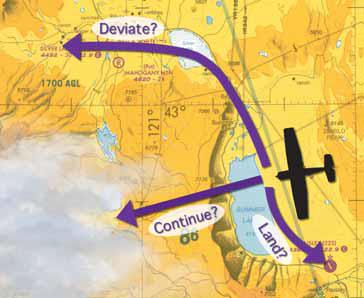
Actual weather conditions in-flight may well be different than expected. This requires a risk management mindset and an understanding of the decision-making process to determine what is different, how it affects your flight, and what you should do about it.
Decision-Making Model
The active decision-making process can be broken down into three basic steps:
- Anticipate
- Recognize
- Act
 Anticipate—What could go wrong? It’s a good idea to maintain an active mental “lookout” for potential problems during flight. Also, recognize that different phases of flight—such as climb, cruise, and approach—call for different degrees of anticipation.
Anticipate—What could go wrong? It’s a good idea to maintain an active mental “lookout” for potential problems during flight. Also, recognize that different phases of flight—such as climb, cruise, and approach—call for different degrees of anticipation.
Recognize—Has something gone wrong? Avoid problems in flight by paying attention! The sooner you recognize a problem and start thinking about how to handle it, the better. Insidious problems can be difficult to detect if you’re not paying close attention. For example, deviations from the weather forecast en route can be quite subtle. Stay alert and look for things that don’t seem normal, or don’t fit with expectations—anything that gives you “cause to pause.” This signals that the situation is changing—possibly for the worse—and that you may need to take action.
Act—Evaluate your options and choose one. Here’s where many pilots fail. They recognize the problem, but don’t do anything to confront it. Why? It’s inconvenient. It means a major change in plans, and it may mean making a difficult or unpleasant choice. Regardless, once you’ve recognized a problem you need to make a choice. That choice depends upon a number of factors—the type and seriousness of the problem, the rate at which the situation is deteriorating, and the available alternatives. Be prepared to act without delay, should the situation warrant it.
Accident Case Study: VFR into IMC
VFR flight into instrument meteorological conditions is a leading cause of fatal GA accidents. This video re-creates an actual VFR-into-IMC accident and examines the lessons we can learn from it.
In-Flight Weather Sources
ASOS/AWOS—Tuning into ASOS and AWOS frequencies is a great way to keep up with surface weather conditions.
Datalink—SiriusXM (satellite-based technology) or ADS-B In (ground-based technology) allows you to obtain near real-time weather graphics and data right in the cockpit.
Other Pilots—Knowing what’s ahead can be as simple as listening to other pilots on frequency. If others are deviating for ice or heavy precipitation along your route, it’s better to change plans soon.
ATC Radar—This can be very helpful as long as you keep in mind that the system depicts solid objects such as precipitation only. It can’t detect clouds, fog, haze, and other visibility reducing weather, so ATC can’t warn you about IMC or developing weather that hasn’t produced precipitation yet.
ADS-B or SiriusXM? What’s Right For You?
Watch and decide which product is right for your style of flying.
Watch OAT
Watch the outside air temperature (OAT) gauge throughout the flight—especially during the climb—to check if the temperatures at different altitudes are as expected. This is any easy way to validate the overall forecast while determining the freezing level for the current location.
Note: Be aware that the OAT probe may be affected by ice accretion or being wet. Also, in-flight adiabatic compression and evaporation cooling will affect the temperature shown by several degrees, depending on conditions.
Detecting Ice
How do you detect ice in flight? Here are a few tips.
Carburetor Ice—With a carbureted engine, watch the rpm or manifold pressure to detect any loss of power. This will be the first indication of carburetor ice.
Visual—Structural ice will likely form first on small parts of the aircraft that protrude into the airflow, like the wings and propellers.
Flashlight—For night flights, use a flashlight that is bright enough to inspect for ice from the cockpit. Don’t’ forget to carry extra batteries!
Flying the Weather: Picking Up Ice
Early detection of ice accumulation is critical to the safe outcome of a flight—even for pilots flying in aircraft equipped with de-icing equipment. In this video, Tom Horne talks about what to look for—and where—to determine if your aircraft is starting to pick up ice.
Ice Contamination and Its Effect
How quickly a surface collects ice depends in part on its shape. Thin, modern wings will be more critical with ice on them than thick, older wing sections. An airplane’s tail surfaces will normally ice up much faster than the wing.
Wing Stall— Stall characteristics will be degraded. The wing will stall at a lower angle of attack and a higher airspeed and ice accretions may be asymmetric between the two wings. Ice on the wings forward of the ailerons can seriously affect roll control. Wings on GA aircraft are designed so that a stall starts near the wing’s root and progresses outward—so the stall does not interfere with roll control of the ailerons. However, the outer wing (generally thinner and a better ice collector) may stall first rather than last. This can lead to a partial stall of the wings at the tips, which can affect the ailerons and therefore roll control.
Tail Stall—The horizontal stabilizer balances the tendency of the nose to pitch down by generating downward lift on the aircraft’s tail. When the tail stalls, this downward force is lessened or removed, and the aircraft’s nose can severely pitch down. Because the tail has a smaller leading edge radius and chord length than the wings, it can collect proportionately two to three times more ice then the wings and, often, this ice accumulation is not seen by the pilot.
 Note: Although GA aircraft are more commonly prone to a wing stall, you should know if the aircraft you fly is susceptible to an ice contaminated tailplane stall (ICTS).
Note: Although GA aircraft are more commonly prone to a wing stall, you should know if the aircraft you fly is susceptible to an ice contaminated tailplane stall (ICTS).
Your Options
Avoid an icing encounter in weather conducive to ice. When flying from an area with no precipitation into an area with precipitation, the best immediate action is to turn around and go back where it was clear—then evaluate your options:
- Fly a different course to your destination
- Divert to an alternate airport
- Return to your departure airport
Tip: Give PIREPs if you encounter unexpected precipitation or ice. If it’s serious, tell ATC so they can share the information to help other pilots. The PIREPs you give also help improve forecasts.
Icing Encounter
If you encounter ice, advise ATC immediately when the ice first start to build, not after the situation is critical.
- Priority handling. Ask for priority handling and deviations to exit the icing conditions. The sooner they are aware, the better are your chances to escape the conditions. Be flexible and help ATC by being willing to accept altitude and heading changes, this will help them expedite your request.
- Deviate, declare an emergency, and say intentions. If ATC can’t help within a reasonable amount of time, remember that it’s legal to deviate from ATC’s instructions in an emergency. If that’s the case, deviate and do whatever is necessary to deal with the situation. Then when there’s time, declare an emergency and let ATC know your intentions.
- Avoid abrupt and excessive maneuvering.
- Autopilot. Do not engage the autopilot (if it is engaged, hold the control wheel firmly and disengage the autopilot).
- Angle of attack. If you observe an unusual roll response or an un-commanded roll control movement, reduce the angle of attack.
- Flaps. Do not extend flaps when holding in icing conditions. If flaps are extended, do not retract them until the airframe is clear of ice.
- Report. Tell ATC about these conditions.
Tip: Contrary to popular belief, declaring an emergency usually doesn’t result in paperwork and FAA enforcement actions. Get help when you need it and worry about the consequences later.
Accident Case Study: Airframe Icing
Ride along for this chilling re-creation and analysis of an accident that occurred when the pilot of a Cirrus SR22 encountered unforecast icing over the Sierra Nevada mountains.
Iced Approach and Landing
Most icing accidents occur in the approach and landing phase of flight. If you encounter structural ice, the following can help to ensure a safe landing:
- If on top of ice-laden clouds, request ATC’s permission to stay on top as long as possible before having to descend.
- Avoid using flaps.
- Increase the approach speed 20 to 25 percent to compensate for increased stall speed.
- Speed discipline is essential.
- Be cautious maneuvering and turning, the stall potential is high.
- If you have a choice, use an airport with the longest runway (landing distance will be much longer than normal because of increased airspeed).
- Turn the windshield defroster on high if you don’t have windshield anti-ice.
- Fly a stabilized approach on final.
- Delay extending the landing gear until reaching the runway is assured.
- The runway may be contaminated, which will affect the amount of runway needed on landing.
Real Pilot Story: Ambushed by Ice
This pilot picked up enough ice to nearly bring down his Cessna 182. Climb in the right seat as he recounts the tale of his unexpected struggle in ice-filled clouds and review some critical facts before venturing anywhere near ice.
Safety Tip: Runway Conditions
Are you familiar with the reporting language used to describe runway landing surface grip? This video shows how the Runway Conditions Assessment Matrix (RCAM) can help you anticipate your airplane's braking performance in bad weather.

